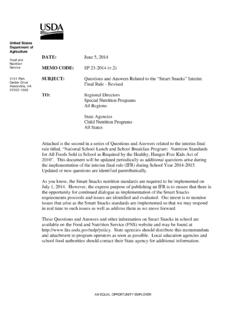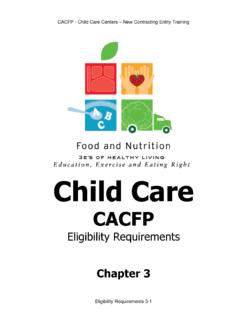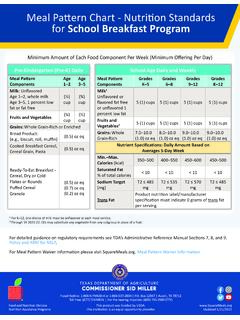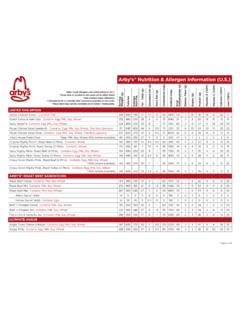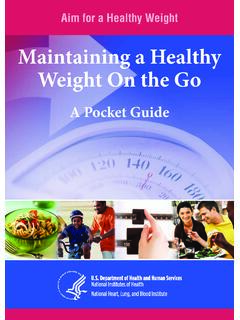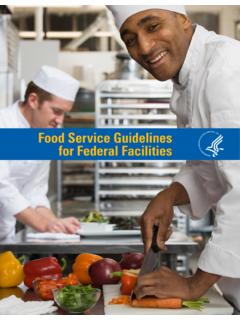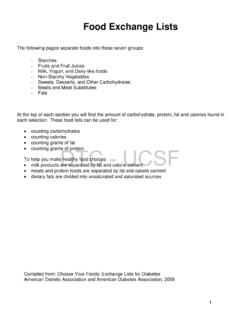Transcription of Nutrition Standards for All Foods Sold in School
1 Nutrition Standards for All Foods Sold in School food /Nutrient Standard Exemptions to the Standard General Standard for To be allowable, a competitive food item Fresh fruits and vegetables with no Competitive food . must: added ingredients except water are (1) meet all of the proposed exempt from all nutrient Standards . competitive food nutrient Standards ; and Canned and frozen fruits with no (2) be a grain product that contains added ingredients except water, or 50% or more whole grains by are packed in 100% juice, extra light weight or have whole grains as the syrup, or light syrup are exempt first ingredient*; or from all nutrient Standards . (3) have as the first ingredient* one of the non-grain main food groups: Canned vegetables with no added fruits, vegetables, dairy, or protein ingredients except water or that Foods (meat, beans, poultry, contain a small amount of sugar for seafood, eggs, nuts, seeds, etc.)
2 ; or processing purposes to maintain the (4) be a combination food that contains quality and structure of the at least cup fruit and/or vegetable are exempt from all vegetable; or nutrient Standards . (5) contain 10% of the Daily Value (DV). of a nutrient of public health concern ( , calcium, potassium, vitamin D, or dietary fiber). Effective July 1, 2016 this criterion is obsolete and may not be used to qualify as a competitive food . *If water is the first ingredient, the second ingredient must be one of items 2, 3 or 4. above. NSLP/SBP Entr e Any entr e item offered as part of the lunch Items Sold A la Carte. program or the breakfast program is exempt from all competitive food Standards if it is sold as a competitive food on the day of service or the day after service in the lunch or breakfast program. Sugar-Free Chewing Sugar-free chewing gum is exempt from all Gum competitive food Standards .
3 Grain Items Acceptable grain items must include 50% or more whole grains by weight, or have whole grains as the first ingredient. Total Fats Acceptable food items must have 35% Reduced fat cheese (including part- calories from total fat as served. skim mozzarella) is exempt from the total fat standard. Nuts and seeds and nut/seed butters are exempt from the total fat standard. food /Nutrient Standard Exemptions to the Standard Products consisting of only dried fruit with nuts and/or seeds with no added nutritive sweeteners or fats are exempt from the total fat standard. Seafood with no added fat is exempt from the total fat standard. Combination products are not exempt and must meet all the nutrient Standards . Saturated Fats Acceptable food items must have < 10% Reduced fat cheese (including part- calories from saturated fat as served.)
4 Skim mozzarella) is exempt from the saturated fat standard. Nuts and seeds and nut/seed butters are exempt from the saturated fat standard. Products consisting of only dried fruit with nuts and/or seeds with no added nutritive sweeteners or fats are exempt from the saturated fat standard. Combination products are not exempt and must meet all the nutrient Standards . Trans Fats Zero grams of trans fat as served ( g per portion). Sugar Acceptable food items must have 35% of Dried whole fruits or vegetables;. weight from total sugar as served. dried whole fruit or vegetable pieces; and dehydrated fruits or vegetables with no added nutritive sweeteners are exempt from the sugar standard. Dried whole fruits, or pieces, with nutritive sweeteners that are required for processing and/or palatability purposes ( , cranberries, tart cherries, or blueberries) are exempt from the sugar standard.
5 food /Nutrient Standard Exemptions to the Standard Products consisting of only exempt dried fruit with nuts and/or seeds with no added nutritive sweeteners or fats are exempt from the sugar standard. Sodium Snack items and side dishes sold a la carte: . 230 mg sodium per item as served. Effective July 1, 2016 snack items and side dishes sold a la carte must be: 200 mg sodium per item as served, including any added accompaniments. Entr e items sold a la carte: 480 mg sodium per item as served, including any added accompaniments. Calories Snack items and side dishes sold a la carte: . 200 calories per item as served, including any added accompaniments. Entr e items sold a la carte: 350 calories Entr e items served as an NSLP or per item as served including any added SBP entr e are exempt on the day of accompaniments. or day after service in the program meal.
6 Accompaniments Use of accompaniments is limited when competitive food is sold to students in School . The accompaniment must be included in the nutrient profile as part of the food item served and meet all proposed Standards . Caffeine Elementary and Middle School : Foods and beverages must be caffeine-free with the exception of trace amounts of naturally occurring caffeine substances. High School : Foods and beverages may contain caffeine. Beverages Beverages Elementary School Plain water or plain carbonated water (no size limit);. Low fat milk, unflavored ( 8 fl oz);. Non fat milk, flavored or unflavored ( 8. fl oz), including nutritionally equivalent milk alternatives as permitted by the food /Nutrient Standard Exemptions to the Standard School meal requirements;. 100% fruit/vegetable juice ( 8 fl oz);. and 100% fruit/vegetable juice diluted with water (with or without carbonation), and no added sweeteners ( 8 fl oz).
7 Middle School Plain water or plain carbonated water (no size limit);. Low-fat milk, unflavored ( 12 fl oz);. Non-fat milk, flavored or unflavored ( 12 fl oz), including nutritionally equivalent milk alternatives as permitted by the School meal requirements;. 100% fruit/vegetable juice ( 12 fl oz);. and 100% fruit/vegetable juice diluted with water (with or without carbonation), and no added sweeteners ( 12 fl oz). High School Plain water or plain carbonated water (no size limit);. Low-fat milk, unflavored ( 12 fl oz);. Non-fat milk, flavored or unflavored ( 12 fl oz), including nutritionally equivalent milk alternatives as permitted by the School meal requirements;. 100% fruit/vegetable juice ( 12 fl oz);. 100% fruit/vegetable juice diluted with water (with or without carbonation), and no added sweeteners ( 12 fl oz);. Other flavored and/or carbonated beverages ( 20 fl oz) that are labeled to contain 5 calories per 8 fl oz, or 10.
8 Calories per 20 fl oz; and Other flavored and/or carbonated beverages ( 12 fl oz) that are labeled to contain 40 calories per 8 fl oz, or 60. calories per 12 fl oz.
